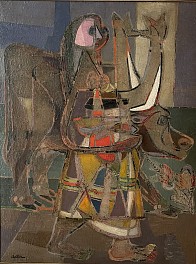BIOGRAPHY

Polish-Jewish (1895-1949)
Avant-garde artist Jankel Adler was known for his cubist-inspired expressionist compositions. His work was greatly influenced by Picasso, Leger and Klee. Considered a “degenerate” artist by the Nazis, much of his work was destroyed during the war.
Marc Chagall and Paul Klee, Pablo Picasso and Otto Dix, Amedeo Modigliani and Francis Bacon − they all knew Jankel Adler, or were even friends with him. Adler, who was born in Tuszyn near Łódź in 1895, is regarded as an important representative and initiator of modern art. He was at the centre of the artistic avant- garde of the 1920s and was one of its driving forces. He was a member of the "Young Rhineland" group as well as the "Cologne Progressives" and was also politically active in the magazines "Sturm" and "Aktion".
Adler was born into a large Orthodox Jewish family in Poland. All of his nine siblings and his parents were killed during the Holocaust. Like Chagall, Adler defined his individual artistic stance against the background of his Jewish origin, but formed a globally comprehensible pictorial repertoire. As a co-founder of the "Young Yiddish" artists group, he was also an almost ideal target of the emerging National Socialist movement − as a representative of a late Expressionist, Cubist and Constructivist language of form, he was denounced as a "cultural Bolshevik" by the Nazis. While he was able to flee to Paris in 1933 and later to London, his works were branded as "degenerate art", shown in the exhibitions of the same name in Munich 1937 and in Berlin 1938, removed from the museums, sold at drastically undercut prices, and sometimes even destroyed.
